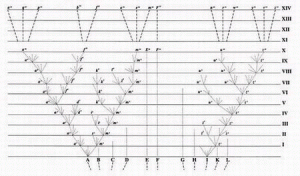Last year in the New England Journal of Medicine, Children’s informaticians Kenneth Mandl, MD, MPH and Isaac Kohane, MD, PhD made an analogy between evolution and the development of new electronic medical records technology. “Just as evolution requires variety in order to create ecosystem niches,” they wrote, “a platform that supports diverse applications will lead to a robust health information economy.”
This got me thinking about the current state of affairs: a limited number of companies designing information systems that don’t integrate well with each other and can’t rapidly adapt to changing end-user needs or advances in information technology. Systems that contain proprietary pieces that don’t talk to each other or block access and exchange with other systems. This seems like what you’d expect in a population if there was no introduction of variation through mating.
What if it weren’t possible to mate within species? What if the offspring of an individual mirrored the qualities of the parent? How well would these offspring evolve and adapt to conditions like famine or a natural disaster? Not likely very well. Darwin long ago demonstrated that variation is the key to species fitness and survival.
Why, then, aren’t existing medical record systems evolving with the changing technology and healthcare environment? Why are different systems not compatible and interoperable? When patients change doctors, move to community or specialty hospitals to rehab, or get referred to specialists, why can’t their records follow them electronically? Rather than separate sets of records managed by a series of vendors with proprietary formats, why not design systems in a way that allows users to manage their own record and combine the best pieces of different systems or “variation”?
Electronic medical records systems should work like my iPhone. Or at least like the app component of the iPhone which allows any company to program for the device. The platform itself should allow cross-device deploying of apps, or allow for cross-network use, to introduce even more variation to the marketplace. Like the iPhone, the standard record data that is available now should be easily accessible by a standard language, enabling new applications to be made by developers. This way, anyone could think of interesting ways to analyze and display the data: not just the developers employed at a particular company managing that particular record.
There are hundreds of thousands of iPhone applications. Depending on my needs, I can pick whatever applications suit me because so many companies are constantly innovating new solutions. Applications are forced into competition with one another just like traits in Darwinian evolution. Only the best or most useful applications will be adopted by iPhone users. As time goes on, developers will constantly improve the applications to meet the changing needs of consumers.
If only our medical record platforms were the same. Rather than just being stuck with the functionality offered by a single company, the patient could purchase inexpensive add-ons from wherever they like. Working with a single company’s system, without the ability to borrow from other systems, is like a species that is not introducing variability by mating.
Fortunately, a health IT system that allows for “evolution” is under development now, and was introduced to outside developers at a meeting this August. It is called the SMArt platform and it was designed by Kohane and Mandl. Right now they are in the process of ”SMArt-enabling” the Indivo personally-controlled health record so that outside developers can design apps that will access the data contained in it for processing. One pilot application allows an individual, pharmacist or healthcare provider to immediately see if the patient has had any adverse reactions to drugs in the past. Other future apps might include one that scans your data for metabolic-related information and generates an appropriate diet to mitigate your symptoms or help you lose weight.
I would encourage stakeholders to get behind this open innovation approach to medical records systems. With the rapidly changing landscape of healthcare, records systems need to evolve quickly, or I fear they won’t survive. Record holders should be allowed to choose the functionalities that represent the best available ideas in healthcare IT. Otherwise they might be homogeneous and, frankly, a bit behind the curve. A little app-titude change could really benefit us all.









